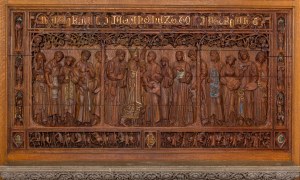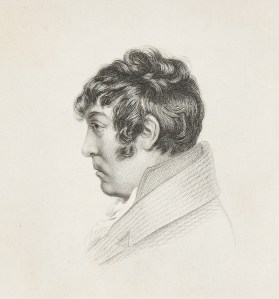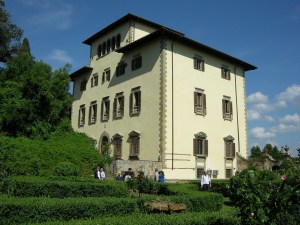On a visit to Cranbrook House, Johannes Kirchmayer’s overmantel is one of the first things to catch your attention. Tours and blog posts have examined this chef d’œuvre and its iconography, and admirers tracing the quotation popping out from the carved eglantine find it a typical George Booth choice: art, nature, his love for both. The inscription reads:
“Nature I loved and next to nature art”
Cranbrook is the Booths’ creation, brimming with art and nature and George Booth quotes, but who wrote this line, and how did it end up in such a prominent spot?

It comes from the pen of Walter Savage Landor.
Born into minor aristocratic wealth in Warwick, England, in 1775, Landor was a wild child, quite possibly because he was sent away to school at 4 ½ years old and was a wonderment to his parents who didn’t know what to do with a child who wrote Latin as well as he wrote English and showed remarkable talent for not obeying rules of any kind.

Landor enjoyed such violent fights over political opinion that his parents banned him from the dinner table when guests were present. No school could hang onto him. Even Trinity College, Oxford had enough of his rebelliousness, his anti-government stance, his French Revolution republican garb. Landor fought back by writing nasty aphoristic poems about his critics in Latin and English, a practice he continued throughout his life. He was particularly vicious in Latin, partly because in England libel laws did not extend to texts in Latin. He was very clever and iconoclastic, favoring social reform and liberal nationalism. He felt himself superior to others and hated competition just in case it might prove him wrong. Hence his epigram, if not epitaph, written on his 74th birthday in 1849:
FINIS
I strove with none, for none was worth my strife:
Nature I loved, and, next to Nature, Art:
I warmed both hands before the fire of life;
It sinks; and I am ready to depart.
He may have been ready to depart, but it would be another fifteen years before he got around to it.
Much earlier, in 1805, Landor inherited a huge amount of money from his father and determined to set up an estate in Wales, restore an abandoned priory on the property, build a large mansion, and reform the peasantry. Impetuous as ever, he flew off to Spain in 1808 to fight in the Peninsular War against Napoleon’s generals, raising his own regiment. Unfortunately, Landor couldn’t stop himself from quarreling with hosts, commanding officers, and his own troops whereupon he fled back to Wales to find building materials for his hoped-for mansion had trickled away much as had his regiment.
Here we enter into the realm of coincidence. Landor, an Englishman, building in Wales, found upon his return from Spain that the locals had run off with a lot of his bricks. In an 1809 letter to the local bishop, Landor cursed the Welsh in his inimitable manner insisting that they would demolish the tomb of famed poet Taliesin if they could get away with it. For those readers who are architecture buffs, the name Taliesin can only conjure up one image, not that of the 5th or 6th century Welsh bard, but that of Welsh-connected Frank Lloyd Wright who thus named his east and west architectural compounds, citing the translation as “shining brow.”
But, back to Landor. Once restored to the throne, the king of Spain sent Landor a flock of sheep in recognition for his services. When the sheep arrived at the English docks, they were assumed to be a gift for the king (George III), and try as he might, Landor could not get them back, and one couldn’t sue the king. He had to wait until George IV died before publishing his opinion, one of his most famous attacks:
George the First was always reckoned
Vile, but viler George the Second.
And what mortal ever heard
A good word of George the Third,
But when from earth the Fourth descended
God be praised the Georges ended.
Alas, even though Landor was able to persuade a lovely young woman, 16 years his junior, to marry him in 1811, all was not well. Quarrelsome as always and with no business sense, Landor fled again from Wales to Fiesole outside Florence in Italy where he fared slightly better. In spite of money troubles and a wife who loved to taunt him about his age, this was the period of his great creativity, writing the totally invented Imaginary Conversations between two famous historical people. Poets such as Byron and Robert Southey loved his work, Byron even doing Landor the honor of stealing the Greek name chosen for a young Landor love to apply to the principal lady in his Child Harold. Readers struggled through these long obscure works (or didn’t) and praised a beautifully succinct passage or two, and those are the excerpts along with his crusty aphorisms that made him famous.

And here is the second coincidence. The inscription in Cranbrook House inspired this blog on Landor, who deserved some recognition. Yet it was while idling in Saarinen House waiting for a COVID-safe tour for Cranbrook students that I found myself looking at the beauty spots of the house. My eye fell on the table in the book room. Upon it lay a couple of tastefully placed little books from the Saarinen collection. I peered at the spine and saw in gold capitals the name LANDOR. They were volumes one and two of his Conversation Pericles and Aspasia, his best-known conversation, first published 1836. The flyleaf revealed the occasion for a gift to Saarinen upon his 60th birthday in 1933, wishing him a happy life, signed G. G. Booth.

Pericles was the great Athenian general of the 5th century BCE Peloponnesian wars, and Aspasia his female companion. Their conversation by Landor is a series of letters between the lovers and their immediate companions with walk-on roles for Aeschylus, Pindar, Socrates, and Alcibiades.
The language is high-flown and not all that accessible; no wonder Landor is hardly known today.
He continued to quarrel with everyone, finally getting thrown out of his own house in 1835 at age 60 by wife, daughter and one son, and fled Italy after scurrilous Latin verses excited the authorities. Back in England, as irascible as ever, Landor continued to write conversations and poems and found himself the grand old man of letters as his fame grew. Carlyle, Tennyson, Browning, Trollope, and Dickens (Landor appears in Bleak House as Lawrence Boythorn) were admiring dinner companions when Landor wasn’t in too bad a temper.
His last six years were spent back in Italy. He died, escaping as usual, in a hotel in Florence in 1864. The villa was later bought by explorer Willard Fiske and renamed Villa Landor. The villa, altered over the years, is now the Fiesole School of Music, echoing no doubt to the rages and laughter of its most prominent owner. Llanthony Priory continued to decay until protected by the Welsh government cultural group, Cadw.
Even though Landor’s life can hardly have met his approval, it is not surprising, perhaps, that George Booth found a quote from the grand old man of the previous century to adorn his own masterpiece, though one might find the use of the word “strife” ambiguous. Just as well Booth chose only the line that suited his purpose: “Nature I loved, and, next to Nature, Art.” The grand old man has come to rest.
–Lynette Mayman, Collections Interpreter



This entry is a treasure, a small masterpiece! Kirchmayer’s overmantel, Landor, Byron, Taliesin … Wright, Booth, Saarinen… Pericles and Aspasia, the Spanish War against Napoleon, Wales and Italy … Bravo!
LikeLiked by 2 people
A much appreciated article well done. Thank You, M. Ross Baldw
LikeLike
Thanks for this informative article. Had no idea of Landor’s life although I mentioned him in every tour I gave. Thanks again. Rhoda Raider
Sent from the all new Aol app for iOS
LikeLike
Thank you for the history of the poetry and it’s master.
Sent from my Verizon, Samsung Galaxy smartphone Get Outlook for Android
________________________________
LikeLike